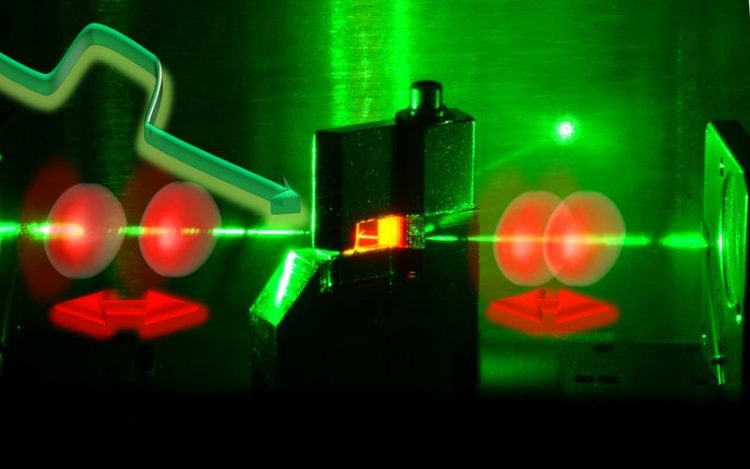Always on beat: ultrashort flashes of light under optical control

Light pulses can form pairs in ultra-short pulse lasers. The pulse intervals (red) can be precisely adjusted by making certain changes to pump beam (green). Image: UBT
Laser pulses have long been utilized in research laboratories, industrial production, and medical therapies. In these applications it is often crucial that the pulses – also known as optical solitons – occur at certain intervals.
Using a special high-speed measurement technique, the researchers have now been able to show how a short-pulse laser widely applied in research can be made to automatically generate pairs of light pulses separated by the desired interval.
All that is required are small disturbances in the green optical “pump beam” (which generates the laser pulses) triggered by electric signals.
The new process centres on the targeted manipulation of solitons, wave packets that can occur in pairs in ultrashort laser pulses. “The resonance excitation and the short disturbance of soliton pairs trigger effects that can be used to specifically control ultrashort laser pulses.
This opens up an exciting new area of research with a yet unforeseeable range of possible applications,” said Prof. Dr. Georg Herink from Bayreuth, corresponding author of the new study. “At the right frequency, a tiny external modulation of the laser is all you need, and ultrashort laser pulses are set into reciprocal, resonant oscillation.
Similar phenomena can be observed in water molecules heated in the microwave,” added lead author Felix Kurtz from Göttingen.
The newly published findings show that in the future, ultra-short pulse lasers will not only be considered as a tool, but also remain a fascinating object of research.
Prof. Dr. Georg Herink
Experimental Physics VIII
University of Bayreuth
Phone: +49 (0)921 / 55-3161
E-mail: georg.herink@uni-bayreuth.de
F. Kurtz, C. Ropers, G. Herink: Resonant excitation and all-optical switching of femtosecond soliton molecules. Nature Photonics (2019), DOI: http://dx.doi.org/10.1038/s41566-019-0530-3
Media Contact
More Information:
http://www.uni-bayreuth.de/All latest news from the category: Physics and Astronomy
This area deals with the fundamental laws and building blocks of nature and how they interact, the properties and the behavior of matter, and research into space and time and their structures.
innovations-report provides in-depth reports and articles on subjects such as astrophysics, laser technologies, nuclear, quantum, particle and solid-state physics, nanotechnologies, planetary research and findings (Mars, Venus) and developments related to the Hubble Telescope.
Newest articles

Combining robotics and ChatGPT
TUM professor uses ChatGPT for choreographies with flying robots. Prof. Angela Schoellig has proved that large language models can be used safely in robotics. ChatGPT develops choreographies for up to…

How the Immune System Learns from Harmless Particles
Our lungs are bombarded by all manner of different particles every single day. Whilst some are perfectly safe for us, others—known as pathogens—have the potential to make us ill. The…

Biomarkers identified for successful treatment of bone marrow tumours
CAR T cell therapy has proven effective in treating various haematological cancers. However, not all patients respond equally well to treatment. In a recent clinical study, researchers from the University…





















